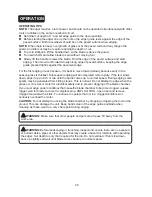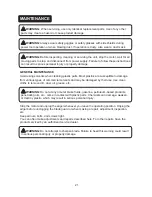
GUIDELINES FOR USING EXTENSION CORDS
USE THE PROPER EXTENSION CORD. Make sure your extension cord is in good
condition. When using an extension cord, be sure to use one of heavy enough gauge to carry
the current your product will draw. An undersized cord will cause overheating. The table
below shows the correct size to use depending on cord length and nameplate ampere rating.
If in doubt, use the next heavier gauge.The smaller the gauge number, the heavier the cord.
Make sure your extension cord is properly wired and in good electrical condition. Always
replace a damaged extension cord or have it repaired by a qualified person before using it.
Keep your extension cords away from sharp objects, excessive heat and damp or wet areas.
Use a separate electrical circuit for your tools. This circuit should not be less than #12 wire and
should be protected with a 15 A time delayed fuse. Before connecting the motor to the power
line, make sure the switch is in the OFF position and the electric current is rated the same as
the current stamped on the motor nameplate. Running at a lower voltage will damage the
motor.
Minimum Gauge for Extension Cords (AWG)
(when using 120 V only)
Amp Rating
Total Length of Cord in Feet (meters)
More Than Not More Than 25' (7.6 m) 50' (15 m) 100' (30.4 m) 150' (45.7 m)
Not Recommended
0
6
10
12
6
10
12
16
18
18
16
14
16
16
16
12
16
14
14
14
12
12
ELECTRICAL
WARNING:
THIS EDGER IS FOR OUTDOOR USE ONLY. DO NOT EXPOSE TO RAIN OR USE IN
DAMP LOCATIONS.
WARNING:
ALTHOUGH THIS TOOL IS DOUBLE INSULATED, THE EXTENSION
CORD AND RECEPTACLE MUST STILL BE GROUNDED WHILE IN USE TO PROTECT
THE OPERATOR FROM ELECTRICAL SHOCK.
10
Содержание 060-3808-8
Страница 26: ...26 PARTS LIST...




























